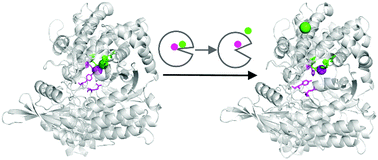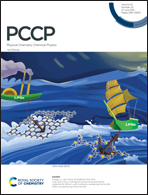Unravelling the inhibitory zinc ion binding site and the metal exchange mechanism in human DPP III†
Abstract
Dipeptidyl peptidase III (DPP III), a zinc-dependent exopeptidase, is widely distributed in organisms and present in almost all human tissues. In addition to its involvement in protein catabolism, it plays a role in oxidative stress and blood pressure regulation, and there is evidence of its involvement in pain modulation. Excess zinc ions have been found to inhibit its hydrolytic activity, but the binding affinity, binding site geometry, and mechanism of inhibitory activity have been unknown. Using several different computational approaches, we determined the inhibitory zinc ion binding site, its coordination and relative binding affinity. During some simulations the translocation of the zinc ion from the inhibitory to the catalytic binding site was observed, accompanied by movement of the catalytic zinc ion toward the exit of the substrate binding site. The traced behavior suggests an associative type of metal ion exchange, in which the formation of the ternary complex between enzyme and two metal ions precedes the exit of the catalytic metal ion. Differently from our previous findings that binding of a peptide induces partial opening of hDPP III, the globularity of the protein did not change in MD simulations of the hermorphin-like peptide bound to hDPP III with two zinc ions. However, the entrance to the interdomain cleft widens during Zn diffusion into the protein and was found to be the highest energy barrier in the process of metal translocation from the solvent to the active site. Finally, we discuss why excess zinc reduces enzyme activity.



 Please wait while we load your content...
Please wait while we load your content...